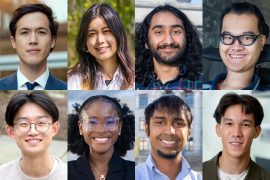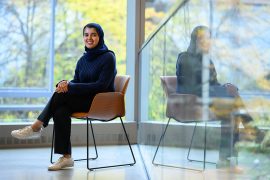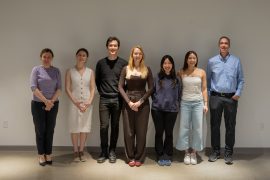The freedom to explore

“MESSY” ISN’T A WORD OFTEN ASSOCIATED WITH SCIENCE AND ENGINEERING, where precision is paramount. But as Sebastian Pineda SM ’20, a third-year doctoral student in electrical engineering and computer science, has found, the path of discovery isn’t always a straight line — and that’s a good thing.
“The process that led me to graduate school and MIT is a little messy,” Pineda explains. A native of Galveston, Texas, Pineda studied electrical engineering and neuroscience at Texas A&M, where he become interested in “working at the interface of electrical engineering and biology.” While a majority of engineering graduate students arrive at MIT with specific research plans, Pineda’s interests were still crystalizing. He knew he wanted to apply his engineering skill set to intriguing questions in biology, and that’s where a Lemelson Presidential Fellowship, which funded Pineda’s first year, provided him with an invaluable asset: “the freedom to explore,” he says.
After a careful search of MIT labs and projects, Pineda found his niche at two of the Institute’s most prestigious research centers: the Computer Science and Artificial Intelligence Laboratory (CSAIL) and the Broad Institute of MIT and Harvard. His research focuses on developing experimental and computation tools to study neurodegeneration and aging at the single-cell level, work that bridges the disciplines of molecular biology and computer science. “I was moving into a completely new field,” he recalls, and the learning curve was steep, but “that’s what I was expecting, coming to MIT.” He hopes his work will lead to a clearer understanding of the mechanisms underlying neurodegenerative diseases like Huntington’s, Parkinson’s, and amyotrophic lateral sclerosis (ALS).
“These are terrible diseases that are almost always fatal. They have no cure, and in many cases no therapy that would even improve a person’s quality of life. It’s a big problem and it affects a lot of people.” Neurodegenerative disease is “one of the modern challenges that we now have the tools to tackle.”
Pineda’s work falls within a new and growing area of molecular biology called single-cell genomics, a field he explains by placing it on the timeline of genomics history. Twenty years ago, says Pineda, the Human Genome Project opened up incredible opportunities “to explore the genetic landscape of an individual or a disease at the molecular level. We can now do that at the resolution of individual cells.” That capability could prove crucial in understanding a disease like ALS, which causes muscle weakness and paralysis. “This is a disease that will kill one very small and particular population of cells in the brain and leave everything else untouched,” says Pineda. “With these new single-cell resolution technologies, we can dissect the mechanisms of those specific populations at a resolution that we couldn’t before.” If successful, he says, research in single-cell genomics could speed the development of treatments, and even cures, for ALS and similar diseases.
Just as the combination of engineering and biology has enriched Pineda’s doctoral work, the contrasts between CSAIL and the Broad Institute have been valuable too. At the Broad, Pineda works in the lab of Myriam Heiman, the Latham Family Career Development Associate Professor of Neuroscience, “a very hands-on, experimental wet lab,” while at CSAIL, he works in the “purely computational, dry lab” of Manolis Kellis ’99, MEng ’99, PhD ’03, professor of computer science. The labs also differ in size and structure; one is small, with a lot of direct engagement with the principal investigator, while the other larger, with more mentorship among the students and scientists. “It’s been beneficial for me and my work to be able to experience both of those settings.” Though he has always leaned toward independent work, Pineda has been happy to discover an aptitude and appreciation for teamwork.
“One of the areas where MIT shines is that it’s very collaborative,” he says. “This is not something you see in many other places: two individuals from completely different fields will get together to solve a problem.” Their approaches, and even the questions they seek to answer, may differ, “but they recognize that by combining their skill sets, they can address previously insurmountable challenges.”
At the start of his doctoral work, Pineda took time to explore the options, and he’s doing that again as he considers career paths after he earns his PhD. For now, the specifics of that future remain open, but whatever direction his work takes, Pineda is confident that “the interface of engineering and biology” will continue to offer captivating challenges.
This article originally appeared in the Fall 2020 issue of MIT Spectrum magazine.


